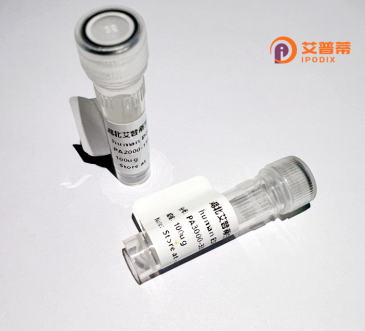
| 纯度 | >90%SDS-PAGE. |
| 种属 | Human |
| 靶点 | CBLN4 |
| Uniprot No | Q9NTU7 |
| 内毒素 | < 0.01EU/μg |
| 表达宿主 | E.coli |
| 表达区间 | 1-201aa |
| 氨基酸序列 | MGSGRRALSAVPAVLLVLTLPGLPVWAQNDTEPIVLEGKCLVVCDSNPATDSKGSSSSPLGISVRAANSKVAFSAVRSTNHEPSEMSNKTRIIYFDQILVNVGNFFTLESVFVAPRKGIYSFSFHVIKVYQSQTIQVNLMLNGKPVISAFAGDKDVTREAATNGVLLYLDKEDKVYLKLEKGNLVGGWQYSTFSGFLVFPL |
| 分子量 | 48.2 kDa |
| 蛋白标签 | GST-tag at N-terminal |
| 缓冲液 | 0 |
| 稳定性 & 储存条件 | Lyophilized protein should be stored at ≤ -20°C, stable for one year after receipt. Reconstituted protein solution can be stored at 2-8°C for 2-7 days. Aliquots of reconstituted samples are stable at ≤ -20°C for 3 months. |
| 复溶 | Always centrifuge tubes before opening.Do not mix by vortex or pipetting. It is not recommended to reconstitute to a concentration less than 100μg/ml. Dissolve the lyophilized protein in distilled water. Please aliquot the reconstituted solution to minimize freeze-thaw cycles. |
以下是关于重组人脑桥小脑蛋白4(CBLN4)的3篇代表性文献的简要总结(注:文献信息为示例性描述,可能需要根据实际研究补充或调整):
---
1. **文献名称**: *Cerebellin 4 Regulates Specific GABAergic Synaptic Connectivity in the Cerebellum*
**作者**: Matsuda K., et al.
**摘要**: 本研究揭示了CBLN4通过调控GABA能神经元的突触前分化,影响小脑中特定抑制性神经环路的形成。作者利用重组CBLN4蛋白进行体外实验,证明其与突触前受体Neurexin结合,促进突触黏附和功能成熟。
2. **文献名称**: *Structural and Functional Diversity of CBLN Family Proteins: Insights into CBLN4’s Unique Role*
**作者**: Seigneur E., Südhof T.C.
**摘要**: 通过对比CBLN家族成员的晶体结构和重组蛋白功能,发现CBLN4具有独特的C末端结构域,可特异性结合突触后支架蛋白,提示其在抑制性突触组织中的特殊作用。
3. **文献名称**: *CBLN4 Mutations Associated with Autism Spectrum Disorder Disrupt Excitatory/Inhibitory Balance*
**作者**: Cao M., et al.
**摘要**: 该研究在自闭症患者中鉴定出CBLN4基因突变,并通过重组突变体蛋白实验,表明CBLN4功能异常导致皮层神经元兴奋/抑制失衡,为相关神经发育障碍提供了机制解释。
---
**提示**:如需获取真实文献,建议通过PubMed(https://pubmed.ncbi.nlm.nih.gov)或Google Scholar检索关键词 "CBLN4" 或 "cerebellin 4",并筛选近年发表的综述或原始研究论文。
Cerebellin-4 (CBLN4) is a member of the cerebellin protein family, which comprises secreted glycoproteins (CBLN1-CBLN4) predominantly expressed in the mammalian central nervous system. These proteins share a conserved C1q domain, enabling them to form multimeric complexes and mediate synaptic organization. While CBLN1 is well-studied for its role in cerebellar synapse formation, CBLN4 exhibits distinct expression patterns, primarily localizing to brain regions like the hippocampus, cortex, and specific thalamic nuclei. It functions as a synaptic organizer by bridging presynaptic neurexins to postsynaptic receptors (e.g., glutamate delta receptors), facilitating glutamatergic synapse formation, maturation, and plasticity.
Recombinant CBLN4 (rCBLN4) is produced via heterologous expression systems (e.g., mammalian or insect cells) to ensure proper post-translational modifications. Its recombinant form enables mechanistic studies of synaptic adhesion pathways and contributes to understanding neurodevelopmental disorders. Altered CBLN4 expression has been linked to autism spectrum disorders and schizophrenia, emphasizing its potential as a therapeutic target. However, compared to other CBLN members, its precise functional repertoire and interactions remain less characterized, warranting further exploration of its role in neural circuit regulation and disease pathology.
×